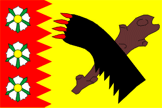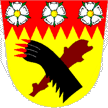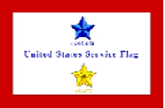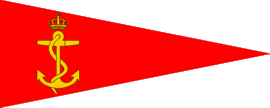- SEMAPHORE
- 1) A system of signalling by means of two flags hand-held in various positions
according to a recognized code (see also
‘Morse code signalling with flags’ and
‘wig wag’).
- 2) A system of signalling by means of movable mechanical arms, now obsolete but
widely used prior to invention of the electric telegraph and at sea sometimes fitted
aboard warships - telegraphing.
- 3) A system of flags, pennants and black shapes hoisted in various positions to
indicate the state and height of the tide in some French ports.
![[semaphore positions]](../images/v/vxt-d289.gif)
Positions in Semaphore (Jim Croft)
Please note with regard to 2), in British RN usage
ships hoisted a designated semaphore flag to indicate that they were about to make
a signal by means of the mechanical semaphore system.
- SEMAPHORE FLAG
- See 'semaphore 2)', and note.
![[semaphore flag]](../images/v/vxt-d1908.gif)
Semaphore Flags (Sea Flags)
- SEMÉ (or SEMY)
- An originally heraldic term used when the field of a flag or shield is
sown or strewn over with an indeterminate number of charges such as
fleur-de-lis or stars – powdered or semy – but see note below (also ‘billetty’
and ‘ermine’).
![[a semy flag]](../images/v/vxt-d1537.gif)
![[semy]](../images/v/vxt-d1409a.gif)
![[a semy flag]](../images/v/vxt-d1409b.gif)
![[a semy flag]](../images/v/vxt-d2590a.gif)
![[a semy flag]](../images/v/vxt-d2590.gif)
Banner of France c1200 – c1350 (fotw); National Flag of France 1814 – 1830 (fotw); Arms and Flag of
Zumberak, Croatia (fotw); Former Arms and Flag of Alvalade, Portugal (Sérgio Horta)
Please note that in vexillology the term may be used even if the number and disposition of the charges are strictly determined as in, for example, the US national jack.
![[a semy flag]](../images/v/vxt-d1539.gif)
Traditional Jack, US (fotw)
- SEMÉ (or SEMY) OF BILLETS
- See ‘billetty’.
![[a semy flag]](../images/v/vxt-d1204.gif)
Flag of Dully, Switzerland (fotw)
- SEMEION (or SEMEIA)
- A cruciform vexilloid of classical Greece used aboard ship (to indicate command, for
signalling and for identification) and sometimes draped with a phoinikis or purple
cloak/length of cloth (see also ‘standard 5)’ and
‘vexilloid 2)’).
Notes
a) The word semeion had a broad range of meanings in classical
Greek all roughly corresponding to “sign” (see also ‘signum’) and it is accordingly
suggested that the definition given above (whilst based on written sources) must be considered to some
degree conjectural.
b) Semeia is the plural form of
semeion, and that classical
Greek writers also refer to “barbarian semeia” with those of the Phoenicians recorded as having been a globe and
crescent.
- SEMI
- See ‘demi’.
![[a semi flag]](../images/v/vxt-d1252.gif)
Flag of Wildberg, Switzerland (fotw)
- SEMI-CIRCULAR (or SEMICIRCULAR) SHIELD
- The term used in some European heraldic systems (albeit inaccurately) to
describe a round-bottomed or Spanish-style shield – see ‘Spanish-style shield’
(also ‘French shield’, ‘Gothic shield’,
‘Italian shield’, ‘rectangular shield’,
‘shield 2)’ and ‘triarched triangular shield’).
![[example]](../images/v/vxt-d2755.gif)
Arms of Dobříň, Czech Republic (fotw)
- SENDAL
- A fine silk fabric originally used as a field for the finest quality of various
flags - cendal.
- SENIOR OFFICER AFLOAT PENNANT
- A pennant hoisted to indicate the senior officer's ship when several warships
of the same navy are alongside or at anchor in a port – a senior officer present
afloat pennant (see also 'broad pennant',
'command pennant' and
'flag of command').
It should be noted however, that many different designs are in use by different
navies, and that these might also have differing or additional meanings.
![[Senior Officer Afloat pennants]](../images/v/vxt-d293.gif)
From left: Argentina (CS); Estonia (CS); France, French Forces
only (CS)
Please note that a green, white and green square-ended
pennant – the starboard pennant in the NATO signal code - is used for this purpose
(at the starboard yardarm) by all warships of the Alliance, but usually only when
there is no flag officer present who is flying his flag afloat. It is, however,
also employed to indicate the senior officer when ships of more than one NATO
navy are present in a port, irrespective of whether any flags of command or broad
pennants are flying.
![[starboard pennant]](../images/v/vxt-d295.gif)
The NATO Starboard Pennant (CS)
- SEPALS
- See ‘barbed’.
![[Lancashire flag]](../images/v/vxt-d2968.gif)
Flag of Lancashire, UK (fotw)
- SERAPIS FLAG
- See ‘Franklin flag’
![[Serapis flag]](../images/v/vxt-d473.gif)
The Serapis/Franklin Pattern of Stars and Stripes, 1778 (fotw)
- SERGEANT MAJOR'S COLOUR (or COLOR)
- See ‘stand of colours 1)’ and ‘venn’.
![[Sergeant Major’s Colours example]](../images/v/vxt-d2390a.gif)
![[Sergeant Major's Colours example]](../images/v/vxt-d2390b.gif)
Examples of Sergeant Major’s Colours in Venn A and Venn B, English c1641 (fotw)
Please note that these flags relate to the field officer whose rank was immediately below that of Lt Colonel, and
not to a regiment’s senior non-commissioned officer as is modern usage.
- SERRATED
- 1) The vexillological term for a saw-toothed line on a shield, banner of arms or a flag –
but see note b) below (also
‘nettle leaf’
‘stepped’and
‘wolfteeth’).
- 2) A term that may be used for a saw-toothed stripe – a zigzag (see also ‘wavy’).
![[Bahrain - serrated flag]](../images/v/vxt-d297.gif)



National Flag of Bahrain (fotw); Flag and Arms of
Milíkov, Czech Republic (fotw); Civil Ensign of Taiwan (fotw)
Notes
a) With regard to 1), the five white points on the flag
of Bahrain (illustrated above) refer to the five pillars of Islam.
b) The heraldic terms to describe this type of division are ‘indented’ or
‘dancetty’.
- SERVICE ENSIGN
- 1) See under ‘ensign’.
![[Postal flag - Norway]](../images/v/vxt-d407.gif)
Former Postal Ensign/Flag of Norway (fotw)
- SERVICE FLAG (or BANNER)
- 1) See ‘state flag 1)’ (also
‘state service flag’).
- 2) See ‘ensign 2)’ plus ‘government ensign’
and ‘service ensign’ under ‘ensign’.
- 3) In US usage, a flag (instituted in 1926) flown annually at the Capitol, Washington on Armistice Day
(11 November) to commemorate those who served or are serving in the armed services of that country – an
American war mothers or armistice day flag.
- 4) In largely North American usage, a flag/banner (originally introduced
in 1917) for display by families, employers,
or other organizations to signify that one or more members is/are serving in the armed
forces – a sons in service flag or national service flag/banner.





From left: Armistice Day Flag, US (Dave Martucci); Service Flags US (fotw); Canada (CS)
Please note with regard to 4) that a gold star (as illustrated above) or emblem indicates that the person being represented
has died in service.
- SERVICE OF CONSECRATION
- See ‘consecration’.
- SERVICE PENNANT
- The generic term – and a direct translation of the German dienstwimpel – for an
increasingly obsolete type of pennant that is sometimes flown (in varying forms) together with the government ensign or
from the mainmast of vessels in government employ to indicate the function or service
involved, or occasionally from an appropriate shore based establishments – a departmental pennant (see also ‘government
ensign’ under ‘ensign’ and
‘main’).



The DDR Shipping Inspectorate, 1955-90 (fotw); Lifesaving Service, US (fotw); Icebreaking Service, Denmark (fotw)
![[semaphore positions]](../images/v/vxt-d289.gif)
![[a semy flag]](../images/v/vxt-d1537.gif)
![[semy]](../images/v/vxt-d1409a.gif)
![[a semy flag]](../images/v/vxt-d1409b.gif)
![[a semy flag]](../images/v/vxt-d2590a.gif)
![[a semy flag]](../images/v/vxt-d2590.gif)
![[a semy flag]](../images/v/vxt-d1539.gif)
![[a semy flag]](../images/v/vxt-d1204.gif)
![[a semi flag]](../images/v/vxt-d1252.gif)
![[example]](../images/v/vxt-d2755.gif)
![[Senior Officer Afloat pennants]](../images/v/vxt-d293.gif)
![[Lancashire flag]](../images/v/vxt-d2968.gif)
![[Serapis flag]](../images/v/vxt-d473.gif)
![[Sergeant Major’s Colours example]](../images/v/vxt-d2390a.gif)
![[Sergeant Major's Colours example]](../images/v/vxt-d2390b.gif)
![[Bahrain - serrated flag]](../images/v/vxt-d297.gif)



![[Postal flag - Norway]](../images/v/vxt-d407.gif)









![[semaphore flag]](../images/v/vxt-d1908.gif)
![[starboard pennant]](../images/v/vxt-d295.gif)